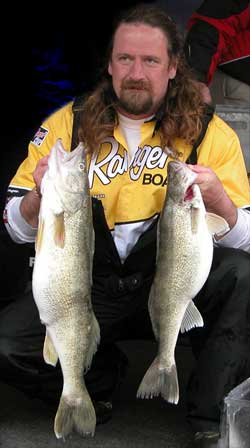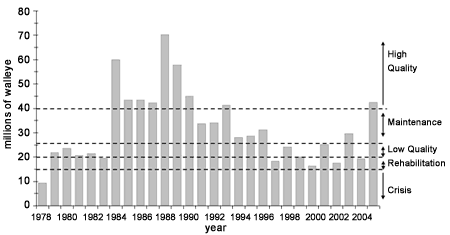Detroit River-Western Lake Erie Basin Indicator Project
Walleye Population of Lake Erie
Background
Walleye live and breed in Lake Erie and the Detroit River. As juveniles, they consume mainly zooplankton, which are microscopic animals, aquatic insects, and other young fish, but their diet changes to mainly small forage fish as they mature. Successful maintenance of walleye populations depends heavily on successful spawning. Many factors affect the success or failure of walleye spawning, including water temperature, currents, wind and storm events, and also a healthy forage base.
As adults, walleye are top predators in Lake Erie's food web. This position makes them good indicators of ecological health not only because their health and distribution are dependant upon a healthy forage base, but also because they impact other populations. As a keystone species, instability in the walleye population could lead to instability in other populations as well. That, in turn, could possibly lead to a compromised ecosystem or deterioration of the fishery.
Annually, approximately three million walleye are harvested from the western and central Lake Erie basins for commercial and sport usage (Figure 1). The fishery is cooperatively managed by the Lake Erie Committee (LEC) of the Great Lakes Fishery Commission. The LEC is a binational group, with representation from the Michigan Department of Natural Resources, the New York State Department of Natural Resources, the Ohio Department of Natural Resources, the Pennsylvania Fish and Boat Commission, and the Ontario Ministry of Natural Resources. Walleye is of enormous economic importance to all jurisdictions (Locke et al. 2005). Conservatively, the walleye fishing economy is valued at tens of millions of dollars annually.

Figure 1. Participant in the Detroit River walleye tournament on April 8th, 2006 (Photo Credit: John Hartig).
Status and Trends
In 1970, legal walleye harvest was prohibited due to mercury contamination coming from the St. Clair and Detroit Rivers. Legal walleye harvest was renewed, on a limited basis, in 1972. International harvest quotas were later introduced in 1976. Throughout the 1980s, the combination of good water quality, many juvenile fish entering the exploitable stock, and management allowed the population to increase (Figure 2). This changed, however, when in the late 1980s to the early 1990s several factors in conjunction with fishing pressure and low amounts of juvenile fish caused walleye productivity in Lake Erie to decrease. Introduction of non-indigenous species, such as zebra mussels and the round goby, caused the food web in Lake Erie to shift from pelagic (open water) to benthic (bottom feeding) diverting energy away from walleye populations. In addition, warmer winters increased the numbers of predators, such as northern pike and muskellunge, present in the spring during spawning. Spawning habitat was also lost, due to urban development, river barriers, lower lake levels, and pollution. These factors induced a decline in the walleye population, beginning in the late 1980s and lasting 10-15 years. A critical minimum in the population was reached in 2000, causing declining angler interest and compromised commercial economics (Locke et al. 2005).

Figure 2. Walleye population (ages 2+) in Lake Erie, 1978 to 2005. Walleye population quality levels: 0-15 million = crisis, 15-20 million = rehabilitation, 20-25 million = low quality, 25-40 million = maintenance, 40 million and higher = high quality.
In an attempt to control the walleye decline and restore the population, a Coordinated Percid Management Strategy was developed (during 2001-2003) by the LEC which set that year's annual "Total Allowable Catch" at 3.4 million fish. It also restricted harvest timing to reduce fishing pressures on isolated spawning walleye. However, due to low reproduction success during this time, the walleye population failed to increase, and the "Total Allowable Catch" was reduced again to 2.4 million fish in 2004 (Locke et al. 2005).
To maintain a healthy fishery, the LEC has determined that the walleye population should be maintained between 25 and 40 million fish ("maintenance level"). This value is desirable to provide sufficient fish for commercial and angler use, and also to promote walleye migration from west to east.
The LEC has been estimating walleye population size in Lake Erie since 1978 (Lake Erie Walleye Task Group 2005). These population estimates are based on systematic gill net sampling, measured fishing effort and harvest, tag recovery rates, and use of mathematical models. Walleye population size in Lake Erie was rated in "crisis" in 1978 and generally increased through the 1980s (Figure 2). From the late 1980s through 2000 the walleye population exhibited a decreasing trend. From 2000 to 2005 it has exhibited an increasing trend, with the population rated as "high quality" in 2005. The "high quality" walleye population of 2005 is attributed to improved management techniques, increased in food availability, and improved reproductive success in 2003.
Management Next Steps
The plan for the management of Lake Erie walleye is a cooperative and collaborative product of the LEC member jurisdictions. It is an example of all of the jurisdictions' commitment to the ongoing sustainability and economic viability of this important fishery. The culture of collaboration is critical to the proper management of the walleye fishery of Lake Erie.
The following are the goal and objective from the "Fish Community Goals and Objectives for Lake Erie" (Ryan et al. 2003) that are relevant to walleye:
Relevant Goal – Secure a balanced, predominantly cool water fish community with walleye as a key predator in the western basin, central basin, and the nearshore waters of the Eastern Basin.
Relevant Objective – Provide sustainable harvests of walleye for all areas of the lake and maintain and promote genetic diversity by identifying, rehabilitating, conserving, and/or protecting locally adapted stocks.
Researchers and managers have collaborated to estimate Lake Erie carrying capacity for walleye in order to help achieve a sustainable population. Further, researchers and managers continuously assess, set management priorities, and take management action in a process of continuous improvement. Both sport and commercial harvest quotas are established by managers to help achieve desired goals and objectives.
Research/Monitoring Needs
To help ensure maintenance of walleye stock diversity and sustainability of the population, a number of areas of needed research and investigation must be addressed. These include:
- mortality (determine if current assessment programs provide accurate estimates of mortality, both at the population and stock-specific levels);
- stock contribution (continue to develop tools to identify stock specific origin of individual fish to determine relative contribution of stocks to the Lake Erie walleye population);
- size selective management (determine the utility and management implications of establishing size limits for angling fisheries and mesh size restrictions for commercial fisheries for achieving fishery objectives);
- seasonal closures of fisheries/sanctuaries (evaluate the value of these techniques in improving fry survival and/or protecting fish before they spawn);
- fish community interactions (identify interactions between populations that might impact production); and
- social and economic effects of population abundance (estimate social and economic impacts of various fishery and harvest objectives in order to maximize benefits).
References
- Lake Erie Walleye Task Group. 2005. Report for 2004 by the Lake Erie Walleye Task Group. Lake Erie Committee, Great Lakes Fishery Commission, Ann Arbor, Michigan.
- Locke, B., M. Belore, A. Cook, D. Einhouse, R. Kenyon, R. Knight, K. Newman, P. Ryan, and E. Wright. 2005. Lake Erie Walleye Management Plan. Lake Erie Committee, Great Lakes Fishery Commission, Ann Arbor, Michigan.
- Ryan, P., R. Knight, R. MacGregor, G. Towns, R. Hoopes, and W. Culligan. 2003. Fish Community Goals and Objectives of Lake Erie. Great Lakes Fishery Commission Special Publication 03-02, Ann Arbor, Michigan.
Contact Information regarding Walleye Population of Lake Erie
Bob Haas
Michigan DNR, Fisheries DivisionE-mail: haasrc@michigan.gov
Michael Thomas
Michigan DNR, Fisheries DivisionE-mail: thomasmv@michigan.gov